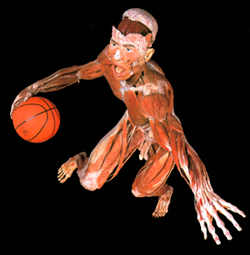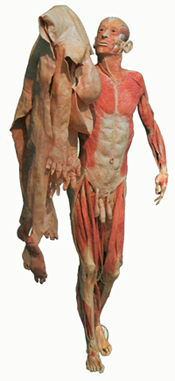
Body Worlds
The Museum for Science and Industry
Chicago, through September 5, 2005
Franklin Institute Science Museum
Philadelphia, October 7, 2005—April 23, 2006
Body Worlds 2
Great Lakes Science Center
Cleveland, through September 18, 2005
Ontario Science Center
Toronto, Spetember 30, 2005—February 26, 2006
The Universe Within
Nob Hill Masonic Center
San Francisco, through September 4, 2005
During my first visit to Thailand, I was invited into the small, sparse room of a young monk. On the wall above his cot hung a disturbing illustration. The left half showed a beautiful blonde woman, in a skimpy bathing suit. The right half of the illustration showed the same woman, in the same pose—but her skin was peeled away. All that remained was muscle, bone, and two grotesque eyeballs.
The grisly Thai image of the flayed but animate corpse—also seen in Tibetan thangkas, and Mexican Day of the Dead figurines—serves, in Buddhist practice, as a tool for ashubha bhavana: contemplation of “unfavorable, impure, and ugly” objects. Ashubha practice is essentially the Buddhists’ reminder that beauty is only skin deep. It’s based on the notion that, to embrace nonattachment and impermanence, we must first come to terms with the visceral reality of our slimy, mechanical bodies.
Two current exhibitions provide an opportunity to meditate on the grosser aspects of anitya, impermanence, while marveling at the architecture of the skeleton, the intricacy of the circulatory system, and the girth of the liver.
The human corpses and organs touring with these shows have been preserved using a technique called plastination: a lengthy, painstaking process wherein every molecule of bodily fluid is replaced with clear silicone. The result is a durable, true-color specimen in which even the tiniest nerves and capillaries remain vivid and intact. It comes as no surprise that the pioneer of this process, a German national named Gunter von Hagen, is famously eccentric; nor that the technique employed in his exhibitions (which have drawn millions of visitors, and netted nearly a billion dollars worldwide) is being imitated by less exacting plastinators eager to cash in on the skin trade.
The two shows produced by von Hagen himself—Body Worlds and Body Worlds 2—feature state-of-the-art plastination. Most, if not all of the bodies, were willingly donated for this purpose. (Mr. von Hagen claims to have more than six thousand volunteers; in the guestbook at the recent Los Angeles show, hundreds of visitors stated not only that they wished to be plastinated, but suggested specific poses.) The other show, The Universe Within, is Body’s World’s dark cousin; it claims to hail from the Peking University Health Science Center, although the PUHSC hotly denies this, and the origin of the bodies (which appear to be Chinese) remains a distasteful mystery. But even if The Universe Within lacks the size, integrity, or informational content of Body Worlds, it does suffice for a leisurely afternoon of Ashubha.

What ultimately makes these exhibits so fascinating—and controversial—is the manner of display. Apart from the organs (which repose in glass display cases, as disembodied lungs and brains will do), the bodies themselves are sculpted. They are shown in action, in poses that living humans might take. The difference is that these bodies are artfully dissected, their muscles and viscera exposed to reveal how the body works, and how we are put together.
One skinless body in The Universe Within, that of a woman of medium height, stands in high heels, reading the Science Times. A young man “rides” a bicycle (the brand name, ironically, is “Forever”), his muscle groups feathered away from their bones. In the larger and more spectacular Body Worlds, a fellow sits before a chessboard, his entire nervous system exposed. A flayed youth plays basketball; a pregnant woman reclines on display, her body eviscerated to show the plastinated eight-month-old fetus within.
An especially striking figure, featured in both shows, is an adult male. He strides forward, smiling. The man’s rippling musculature is fully visible; for he is holding (over his arm in Body Worlds, and on a wooden clothes hanger in Universe) his own complete skin.
Traditionally, human organs and bodies were displayed in formaldehyde. Seeing actual corpses, perfectly preserved in lifelike poses, is stunning. Some, like Tibetan graveyard figures, seem delighted by their freedom from life’s trials. I’m fairly squeamish, but somehow these dissections failed to disturb me. These bodies have been flayed and splayed, split and sawed, sometimes sliced into thin cross-sections, like prosciutto. Faces, fingertips, lips, and sexual organs provide a surreal anchor, connecting the corpses back to their former humanity. On many bodies even the eyelashes and pubic hair remain, islands of sensitivity amidst a sea of capillaries and tendons. On some, there is still dirt under the fingernails.
One gazes into the cavernous wombs, and at the naked testes, and realizes that these people were parents and lovers; they had aversions and preferences; they played in the streets, rode bicycles, drank tea.
I go there, but I can’t stay there. It is hard, after a while, to think of these as dead people; hard to think of them as people at all. The nadis, energy channels, if visible at all, are empty. Their flames of awareness extinguished, the bodies seem no more than mannequins. They are mere matter, with no connection to alaya-vijnana– the “base consciousness” that once animated them. As system and structure, they are nothing short of miraculous—but as I gaze at the exposed hearts and brains, into the sightless eyes and along the narrow nerves, I cannot find the place where awakening occurs.
And perhaps it is not in there at all. Maybe the human body is like an exquisitely complex receiver, designed to decode and express a signal that pervades the space we inhabit. Looking at the bodies and trying to locate awareness might be like tearing apart a television, trying to find the little people inside.
Nonetheless, these were human beings, and we have rituals for releasing our bodies back into their component elements, whether as soil, food, or energy. Even mummies were given elaborate burial rites; mummification itself is a sort of extended ritual. This, I think, is why some viewers find the displays so uncomfortable. Something is missing: an acknowledgment of gratitude, or a space for contemplation.
Both Body Worlds and The Universe Within have visitors’ books near the exits. I leafed through the volume at Universe, amazed at the breadth of reactions.They filled the spectrum, from reverence to disgust. One visitor, suspicious of the bodies’ Chinese origins, had written the mantra of Padmasambhava:
Om ah hung benza guru peme sidhi hung
To the beings on display here
We hope that your contribution to our
understanding was voluntary
Such exhibitions will become increasingly popular, and they are bound to remain controversial. Many people are uncomfortable with any reflection of their mortality and will object to such an “irreverent” display of the deceased. On the other hand, this long-awaited perfection of the embalmer’s art may delight some Theravada communities, who have long created lifelike images of beloved past abbots. Frankly, I find the prospect a bit grisly, sort of a Hinayana House of Wax.
No matter what one’s background may be, it is nearly impossible to view these figures with complete dispassion. The difficulty of dissociating the human form from inherent consciousness was made clear to me at the Body Worlds show in Los Angeles, where I fell into a typical trap.
One of the floor guides—a sweet, stout woman in her early sixties—told me of the discussions she’d had with visitors who felt that turning humans into sculpture, even for educational purposes, was sinful, or just plain wrong.
“They sayin’ all kinds of things.” The woman shook her head. “Wondering what the family of these bodies would think, or the children. Shakin’ their heads, and askin’ how a soul could get any peace like this, on display in some museum, riding a skateboard or wearin’ a bowler hat. They say it’s disrespectful.” She shook her head again. “Can you imagine anything more ridiculous?”
“You’re right,” I replied. “I would think these people would feel proud, seeing their bodies serving a higher purpose than fertilizer. They would feel they were being treated with enormous respect, even reverence.”
The woman looked at me with quiet exasperation. I’d missed her entire point. “Honey,” she said, “these people would not be feelin’ anything. They dead.”
Thank you for subscribing to Tricycle! As a nonprofit, we depend on readers like you to keep Buddhist teachings and practices widely available.